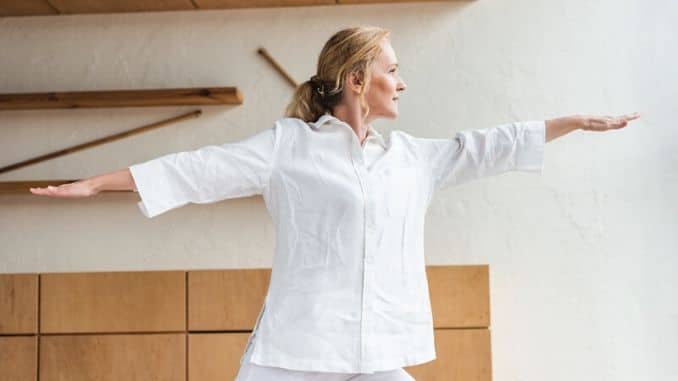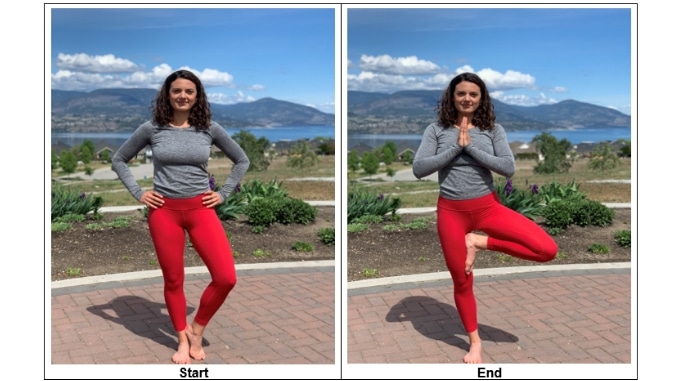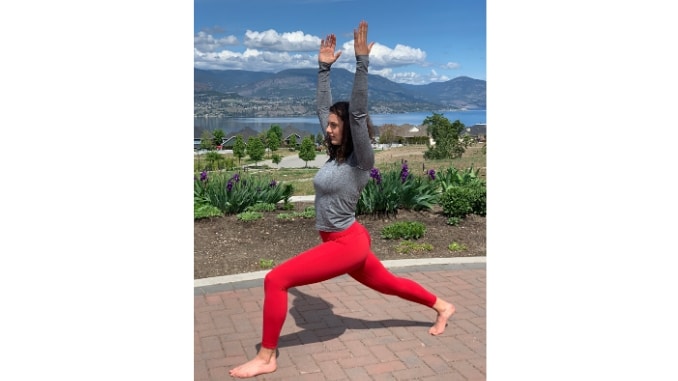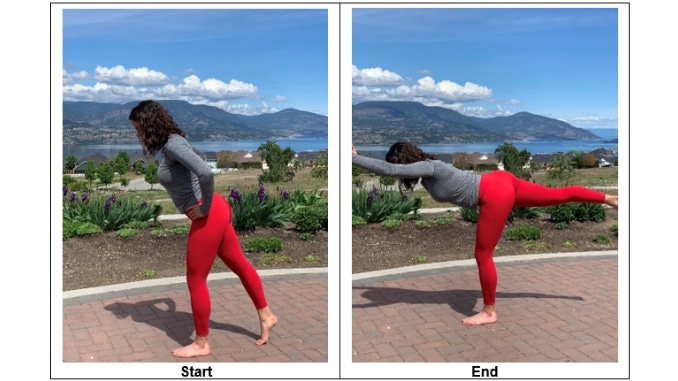
Yoga is an amazing way to improve your balance. Through body awareness, strengthening, and practice, most people find yoga to be incredibly helpful in enhancing their balance abilities. Balance is a very important factor as we age, helping to prevent falls and injuries. The four postures we will walk you through in this article have modifications to help make them accessible for everyone. Always remember to listen to your body and not to do any pose that causes sharp pain or constricts your breathing. Challenge yourself, but stay safe. And most importantly, breathe.
Tree (Vrksasana)

Tree Pose can be very intimidating for people new to yoga or for those with poor balance. This is why there are many different modifications and options for extra support. There is no need to move into the full version of a posture. The level you are comfortable in will work well.
Begin in a standing position. Lift up your toes, spread them apart, and place them back down. Ground down through the three points of your feet; the base of your big toe, the base of your little toe, and your heel. Try to ground down through these three areas equally. Shift your weight onto your right foot and begin to lift your left foot off the floor. Make sure to keep a slight bend in your right knee. This is where you can begin to modify your pose by deciding how high up your right leg you will bring your left foot. Begin by only bringing your left heel to the inside of your right leg while keeping the toes of your left foot on the floor. Feel free to stay here, or raise your left foot onto your inner right calf. As you progress, move the sole of your left foot up your inner right leg, avoiding your knee. Keep both hips pointing forward and your core engaged. Place your hands on your hips, move them to the prayer position, or raise them overhead. Keep your shoulders relaxed away from your ears.
Hold this pose for 3-10 breaths, then repeat on the opposite side.
Modifications: As mentioned earlier, you can modify this pose by moving your foot to different points along your inner leg. Feel free to use the wall or some other sturdy surface to help with balance.
Warrior I/High Lunge (Virabhadrasana I)
This high lunge position changes your normal base of support and thus provides you with an opportunity to practice balance.
Begin in a standing position, then step back with your right leg. Move your right leg far enough back that you are able to stack your right heel over your right toes. Pull your right hip forward to square off your hips (both hips are pointing forward). If this does not irritate your knee, work to straighten your right leg by engaging your thigh muscles. With your core engaged, inhale as you lift your arms overhead and relax your shoulders.
Hold this pose for 3-10 breaths, then repeat on the left side.
Modifications: To make this pose easier, lower down onto your back knee. If your knee is uncomfortable, put a pillow or folded blanket under your knee. A shorter stance will also help make this pose easier. You can also use the wall or another sturdy surface to help with balance.
WarriorIII (Virabhadrasana II)
Warrior III is also known as a toppling tree, so don’t worry if you find this pose really challenging. Like tree pose, the full version of this posture can look very intimidating. But don’t worry, there are many levels of this pose that you can try.
Being in a standing position and ground down through your feet like you did in tree pose. Begin to shift your weight onto your right leg and move onto your left toes. Make sure to keep a slight bend in your right knee. This is a perfectly good place to stop and practice your balance. If you want to move further, begin to lift your left foot off the ground behind you, keeping your leg straight. Lower your torso down toward the ground as you lift your left leg off the ground. Point or flex your left toes, depending on what feels best. Be sure to keep your hips parallel with the ground, which probably means dropping your left hip down slightly. The more you engage your core, the easier it will be to balance. Place your hands on your hips, back behind you or out in front of your body.
Hold this pose for 3-10 breaths, then repeat on the left side.
Modifications: As mentioned earlier, you can slowly work your left foot higher off the ground. You can also use the wall or some other sturdy surface to help with balance.
Chair (Utkatasana)
Chair pose is also known as awkward pose, so don’t worry if that’s how you feel in this posture. Chair pose is a great way to work on balance and build strength in the body.
Begin in a standing position. Shift your weight back onto your heels and begin to shift your seat back behind you, sticking it out further than you think you should. Aim to keep your knees behind your toes. Raise your arms overhead or keep them down at your sides. Keep your chest lifted and your shoulders down away from your ears. This may mean that your arms are pointing straight out in front of you instead of overhead. Keep your core engaged.
Hold this pose for 3-10 breaths.
Modifications: To make this posture easier, move into a shallower squat by bending your knees less. You can leave your arms down or keep your hands on your hips. You can also place a chair or couch behind you if you are worried about your balance.
These four yoga postures are sure to help improve your balance, but remember that any yoga practice will have balance benefits. I hope these postures inspire you to practice more, and that you use yoga as a way to not only better your balance, but that you reap the benefits of all of the amazing gifts yoga has to offer. If you have any questions, make sure to reach out to our support team at [email protected].
Namaste,
Kiah, RYT 200
And for a comprehensive Yoga routine designed to start your day off feeling refreshed and energized, click here.




